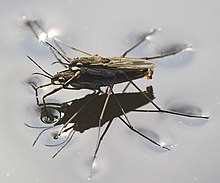User:GreenOnBlue/Water and life
Water has many unusual chemical properties which determine the unique physical properties that makes it ideal as a medium for life to proliferate. All known forms of life depend on it.
Ice
[edit]Very importantly, due to the unusual structure of water molecules, water expands on freezing.[1] This makes it less dense, so ice will float on top of water, rather than sinking, making water freeze from the top rather than the bottom. This insulating effect on the liquid water below it prevents whole bodies of water from solidifying, and so means that life under oceans and other bodies of water can long survive cold periods, below the freezing point of water.

Liquid state
[edit]Water molecules are able to participate in hydrogen bonding[2], a stronger form of dipole interactions, due to the two positively charged hydrogen atoms bonded to a negatively charged oxygen atom. This means the overall forces between water molecules are far stronger than normal, allowing water to remain in the liquid phase at higher temperatures - other substances with a comparable structure would be a gas at room temperature.
Specific heat capacity
[edit]Water has a high specific heat capacity[3], a measure of the amount of energy needed to change the temperature of it. This means that it can absorb large amounts of energy before it begins to warm up; and also cause it to release energy more slowly, causing it to cool more slowly.
This means that it has a stabilising effect on Earth's climate by reducing fluctuations in temperature change.
This property of also beneficial to life as it means organisms can use less energy regulating their body temperature.
Solvency
[edit]Polar molecules, such as water, have large differences in the charges of the atoms they are made up of, causing the molecules themselves to become charged and form dipoles. This makes water useful as a solvent, as many organic molecules have one or more charged hydrophilic functional groups, allowing them to dissolve into water with ease. This aids life greatly, as water can act as a medium to transport charged molecules or ions.

Surface tension
[edit]Because of the strong intermolecular forces, water has a high surface tension, the phenomenon that allows water boatsmen and other small insects to walk across water.
Cohesion/Adhesion
[edit]Molecules of water, instead of spreading out into a thin film, have strong intermolecular forces and so tend to cohere into droplets. Due to the polar nature of water molecules, they also participate in adhesion - cohesion between unlike molecules.
This physical property of water molecules is most clearly seen in the transpirational pull that draws water up the xylem of a plant, which allows the water to adhesively cling to the wall of the xylem and be transported from the roots to the leaves of plants as the water is lost through the stomata of the leaves and negative pressure is created. A similar concept is sucking water up a straw.
pH
[edit]Pure water has a pH of 7, making it neutral. This means that it can act as both a proton donator and a proton acceptor - this allows a larger variety of reactions to take place in water.
The water cycle
[edit]As water exists in solid, liquid and gaseous forms on Earth, a complex negative feedback loop, the water cycle, is set up that results in a greater stablisation in the temperature of Earth.[4]
References
[edit]- ^ The expansion of water upon freezing: http://hyperphysics.phy-astr.gsu.edu/hbase/chemical/waterdens.html
- ^ Hydrogen bonding in water: http://www.lsbu.ac.uk/water/hbond.html
- ^ Specific heat capacity of water: http://hyperphysics.phy-astr.gsu.edu/hbase/thermo/spht.html
- ^ Water vapor in the climate system: http://www.agu.org/sci_soc/mockler.html
